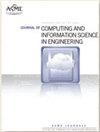Applying Latent Dirichlet Allocation and Support Vector Regression to the Aesthetic Design of Medical Nursing Beds
IF 2.6
3区 工程技术
Q2 COMPUTER SCIENCE, INTERDISCIPLINARY APPLICATIONS
Journal of Computing and Information Science in Engineering
Pub Date : 2023-04-19
DOI:10.1115/1.4062350
引用次数: 1
Abstract
With the development of social productivity and the improvement in material living standards, emotional value has become the core driver of the enhancement of product market competitiveness. A medical nursing bed, one of the most typical types of medical devices, is designed with little attention to the emotional experience of the users. Therefore, this paper proposes an innovative perceptual design approach under the Kansei engineering (KE) framework for resource-limited and information-poor companies. It guides the aesthetic design of medical nursing beds by constructing a mapping relationship between users' perceptual needs and the design characteristics of medical nursing beds to maximize users' emotions. First, latent Dirichlet allocation (LDA) is used to extract usable Kansei semantics from big data, compensating for the subjectivity of traditional KE data input. Then, the design characteristics obtained after deconstructing a medical nursing bed are simplified with rough set theory (RST). Finally, a mapping model between users' perceptual needs and the core design characteristics of nursing beds is established through support vector regression (SVR), and the optimal design solution is obtained by weighting calculation. The optimal combination of design characteristics for medical nursing beds is finally obtained. The results suggest that the design method proposed in this paper can help designers accurately grasp users' emotional perceptions in terms of aesthetic design and scientifically guide and complete the design of new medical nursing beds, verifying the feasibility and scientificity of the proposed method in terms of aesthetic design.潜在狄利克雷分配与支持向量回归在医疗护理床美学设计中的应用
随着社会生产力的发展和物质生活水平的提高,情感价值已经成为提升产品市场竞争力的核心驱动力。医疗护理床作为最典型的医疗器械之一,其设计很少关注用户的情感体验。因此,本文提出了一种基于感性工学(KE)框架的创新感知设计方法,用于资源有限和信息贫乏的公司。通过构建用户感知需求与医疗护理床设计特征之间的映射关系,引导医疗护理床的美学设计,实现用户情感最大化。首先,利用潜在狄利克雷分配(latent Dirichlet allocation, LDA)从大数据中提取可用的感性语义,弥补传统KE数据输入的主观性;然后,利用粗糙集理论(RST)对解构后得到的医疗护理床设计特征进行简化。最后,通过支持向量回归(SVR)建立用户感知需求与护理床核心设计特征之间的映射模型,并通过加权计算得到最优设计解。最终得到了医疗护理床设计特点的最佳组合。结果表明,本文提出的设计方法可以帮助设计师在美学设计方面准确把握用户的情感感知,科学地指导和完成新型医疗护理床的设计,验证了本文提出的方法在美学设计方面的可行性和科学性。
本文章由计算机程序翻译,如有差异,请以英文原文为准。
求助全文
约1分钟内获得全文
求助全文
来源期刊
CiteScore
6.30
自引率
12.90%
发文量
100
审稿时长
6 months
期刊介绍:
The ASME Journal of Computing and Information Science in Engineering (JCISE) publishes articles related to Algorithms, Computational Methods, Computing Infrastructure, Computer-Interpretable Representations, Human-Computer Interfaces, Information Science, and/or System Architectures that aim to improve some aspect of product and system lifecycle (e.g., design, manufacturing, operation, maintenance, disposal, recycling etc.). Applications considered in JCISE manuscripts should be relevant to the mechanical engineering discipline. Papers can be focused on fundamental research leading to new methods, or adaptation of existing methods for new applications.
Scope: Advanced Computing Infrastructure; Artificial Intelligence; Big Data and Analytics; Collaborative Design; Computer Aided Design; Computer Aided Engineering; Computer Aided Manufacturing; Computational Foundations for Additive Manufacturing; Computational Foundations for Engineering Optimization; Computational Geometry; Computational Metrology; Computational Synthesis; Conceptual Design; Cybermanufacturing; Cyber Physical Security for Factories; Cyber Physical System Design and Operation; Data-Driven Engineering Applications; Engineering Informatics; Geometric Reasoning; GPU Computing for Design and Manufacturing; Human Computer Interfaces/Interactions; Industrial Internet of Things; Knowledge Engineering; Information Management; Inverse Methods for Engineering Applications; Machine Learning for Engineering Applications; Manufacturing Planning; Manufacturing Automation; Model-based Systems Engineering; Multiphysics Modeling and Simulation; Multiscale Modeling and Simulation; Multidisciplinary Optimization; Physics-Based Simulations; Process Modeling for Engineering Applications; Qualification, Verification and Validation of Computational Models; Symbolic Computing for Engineering Applications; Tolerance Modeling; Topology and Shape Optimization; Virtual and Augmented Reality Environments; Virtual Prototyping

 求助内容:
求助内容: 应助结果提醒方式:
应助结果提醒方式:


